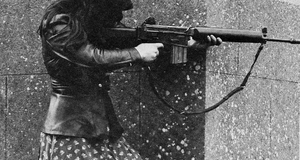From Interstate - Journal of International Affairs VOL. 1996/1997 NO. 2Northern Ireland Revisited
By
Interstate - Journal of International Affairs 1997, Vol. 1996/1997 No. 2 | pg. 1/1
KEYWORDS:
I was prompted to review the situation in Northern Ireland for a number of reasons, not least because my previous article published in this journal now seemed to be a waste of paper in the light of the disappointing end to the IRA cease-fire which consequently affected the ongoing quest for a settlement of the Ireland situation. A settlement which is laden with emotion, characterized most recently by the twenty fifth anniversary of Bloody Sunday, when paratroopers opened fire on a crowd of civil rights demonstrators in Londonderry on January 30 1972. Thirteen unarmed people were killed and no official apology has been made by the British government who still contends that some of the demonstrators were armed and fired upon the troops first. News of the end of the cease-fire reached me while I worked in America, etched in my memory as it- was the first time I had seen John Major in the American news in the whole six months I had been there. This was not surprising considering the considerable part which President Clinton had played in the peace process, including a visit to Belfast, (t he first of its kind) which led to a temporary improvement in relations between the British and Irish governments whose differences were beginning to show. Irish US envoy Mr Mitchell played a key role in the talks culminating in the Mitchell Commission report on January 22 1996 which claimed to have found a formula for ensuring that the decommissioning of arms rut did not bring the peace process to an end. Six principles were put forward including a commitment to democratic and peaceful means of resolving political issues and the total disarmament of all paramilitary organizations. It is easy to forget that over one hundred and fifty thousand weapons are estimated to be in the hands of the Unionists, no wonder Sinn Fein are reluctant to make the first move in a game where ‘saving face’ is more than a political illusion. The illusion, if it was held by any in the British government, was promptly shattered by the Canary Wharf bomb on February 9th. Tim Pat Coogan, author of ‘The Troubles’ attributes this violence directly to John Major’s rejection of the Mitchell commission report which had been met with enthusiasm on both sides of the, Atlantic. The re-socialization of conflict into society which had been hiding in the wings, was quickly to return in the form of flak jackets on the streets of Northern Ireland and the Manchester bomb of June 1996 which resulted in two hundred people being injured and one hundred million pounds worth of damage. The bubble surrounding the possibility of a new era in Ireland appeared to have burst, along with the hopes of the Irish and British people for whom the cease-fire had been the best confidence building gesture in twenty five years of conflict. At the heart of the conflict is the fact that there are several different identities interacting within the Province, each perceiving that it has different interests, and each continually redefining itself by hi lighting its distinctiveness from other competing identities. The only exception being the Protestants in the province, who still view their future as being inextricably linked to Britain, and more importantly wish to see their own government in the Six Counties. This is a concept which British people have a hard time comprehending as outlined in a British white paper,
Hence the label Catholic and Protestant do not have the same meaning in Northern Ireland as in most parts of the world where they would mark purely a religious difference. These terms involve a combination of historic, national, social, economic and other differences all under the heading of religious allegiance. As to the question, ‘how far do religious attitudes cause the northern Ireland conflict?’ It seems there is no single answer, for Catholics the issues are essentially political and economic, but to evangelical Protestants the struggle is one between Christ and Antichrist. At this point it is worth noting that the blanket term ‘Protestant’ covers Ulster British, Ulster Loyalists and evangelical Protestants each with its own distinct network of ancillary organizations. It follows then, that if the Churches were the main source of division there would be a lot more than two communities in Northern Ireland. As has frequently been pointed out, the interests of both communities extend beyond purely sectarian matters. Both have high levels of unemployment and crime combined with poor housing. Residential segregation reinforces each sides way of life and hardens as well as perpetuates attitudes. The segregation continues in education, where few schools are not segregated, making even education divisive, where the same values are espoused through a shroud of a specific political agenda. All these factors will play a large part in any future proposals and served to nurture suspicion towards the nationalist induced peace by the Unionist community. While the Ulster Democratic Party and Progressive Unionist Party accepted as genuine Traditional Loyalists focused on the contradictions and evasions claiming that if the process was genuinely about agreement and there was a total commitment to peace, the IRA had no need for weapons. Nationalists blame the British government for making unrealistic demands of the IRA, Republicans criticize the Irish government for failing to assert itself against the British government and the Unionists and the British government criticize republicans for their unwillingness to decommission any of their weapons. The Anglo-Irish agreement of 1986 established formal institutions which allowed Dublin a greater say in Northern Ireland affairs. Similarly, the Frameworks Documents also explicitly acknowledge the necessary presence of a Dublin government in any meaningful peace process. There is also recognition of outside actors roles, primarily that of the United States. Both the United Kingdom and the Republic of Ireland are members of the European Union as well, so there is scope for this institution to act as a forum to take the peace process forward. After all, it is often not realized that nonviolent action groups are not completely alien to the key players. Indeed the Official IRA briefly adopted this stance which included peaceful marches and sit ins in the 1970s. However, the Protestant community reacted vehemently and as relations in the province deteriorated the British army was sent in to keep the peace that was to culminate in March 1972 with the start of Westminster rule. There is now explicit recognition on the part of the British and Irish governments that a solution to Northern Ireland problems can only be secured both internationally and at local levels. The management of the peace process entails joint co-operation between both Dublin and London (as well, of course, as Belfast). In order to achieve greater integration between the two communities measures must be taken to the local level too with the creation of new institutions not tarnished with the past history of the old ones. For example, schools are currently segregated, perhaps part of the breaking down of communal barriers would be to allow their children to play together. Segregation can exacerbate conflict by increasing mutual ignorance and fostering the growth of stereotypes, in a situation where other reasons for conflict are abundant. The two communities assigned different meanings to the cease-fire and to the holding of arms. Misunderstanding gave way to a struggle for and about power narrowing the possibilities of a settlement to almost impossible odds. Reconciliation is hard in the face of a history of twenty five years of violence, but while it cannot be erased, it could at least be understood and forgiven. Despite of all that has happened, I finish on the same note that I did in 1994:
Suggested Reading from Inquiries Journal
Inquiries Journal provides undergraduate and graduate students around the world a platform for the wide dissemination of academic work over a range of core disciplines. Representing the work of students from hundreds of institutions around the globe, Inquiries Journal's large database of academic articles is completely free. Learn more | Blog | Submit Latest in Political Science |















